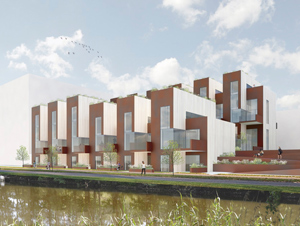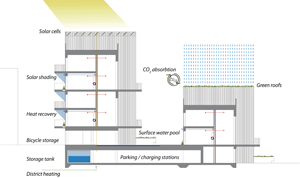 |
 |
 |
 |
 |
 |
| |
 |
|
 |
 |
 |
  |
  |
 |
 |
 |
 |
|
|
 |
|
 |
 |
 |
BUILDING |
 |
|
 |
|
 |
 |
 |
| |
 |
| 
 |
Norra Djurgaardsstaden
Sustainable town houses |
|
 |
 |
 |
 |
DESIGNER |
 |
|
|
 |
|
 |
 |
 |
| |
 |
|
 |
 |
 |
 |
DESCRIPTION |
 |
|
|
 |
|
 |
 |
 |
|
|
 |
 The project makes it possible to live a modern life based on sustainable solutions. The project makes it possible to live a modern life based on sustainable solutions.
The aim of the Norra Djurgaardsstaden housing district is to adapt to global climate changes, so that in 2030 the district will no longer make use of fossil fuels - and thereby not contribute to the emission of CO2. The energy consumption of the living units will not exceed 55 kWh/m²/year, including a maximum of 15 kWh/ m²/year used for electricity.
The energy consumption will be minimized by means of the massing of the buildings, for example, the town houses are staggered in order to maximize daylight and have dense constructions. Also contributing are solutions such as intelligent lighting, solar panels for heating, and heat recovery.
Characteristic for the town houses will also be green roofs with e.g. wild honeysuckle and herbs, which - along with a landscaped pond in the common yard - will collect rainwater, convert CO2, and provide a fertile ground for biodiversity.
The sustainable approach is continuous throughout the building life cycle - from construction phase to operational phase and a possible later decomposition phase, i.e. Cradle to Cradle Design.
Edited by C. F. Møller Architects |
|
 |
 |
 |
|
 |
|
|
|
 |
|
 |
 |
 |
 |
 |
 |
 |
ECO-SUSTAINABILITY |
 |
|
|
 |
|
 |
 |
 |
|
|
 |
 The project makes it possible to live a modern life based on sustainable solutions. The project makes it possible to live a modern life based on sustainable solutions.
The aim of the Norra Djurgaardsstaden housing district is to adapt to global climate changes, so that in 2030 the district will no longer make use of fossil fuels - and thereby not contribute to the emission of CO2. The energy consumption of the living units will not exceed 55 kWh/m²/year, including a maximum of 15 kWh/ m²/year used for electricity.
The energy consumption will be minimized by means of the massing of the buildings, for example, the town houses are staggered in order to maximize daylight and have dense constructions. Also contributing are solutions such as intelligent lighting, solar panels for heating, and heat recovery.
Characteristic for the town houses will also be green roofs with e.g. wild honeysuckle and herbs, which - along with a landscaped pond in the common yard - will collect rainwater, convert CO2, and provide a fertile ground for biodiversity.
The sustainable approach is continuous throughout the building life cycle - from construction phase to operational phase and a possible later decomposition phase, i.e. Cradle to Cradle Design.
Edited by C. F. Møller Architects |
|
 |
 |
 |
 |
 |
 |
 |
LOCATION |
 |
|
|
 |
|
 |
 |
 |

|
 |

|
Continent |
|
 |
|
Nation |
|
 |
|
County |
|
 |
|
Town |
|
 |
|
Borough |
|
 |
|
Hamlet |
|
 |
|
Address |
|
 |
|
|
|
 |
|
 |
 |
 |
 |
MAP |
 |
|
|
 |
|
 |
 |
 |
| |
 |
|
 |
 |
 |
 |
|
TYPOLOGY |
 |
|
|
 |
|
 |
 |
 |
|
|
 |
ARCHITECTURE | Residential buildings
Multiple dwelling
| |
 |
 |
 |
 |
CHRONOLOGY |
 |
|
|
 |
|
 |
 |
 |
Project |
 |
|
 |
| 
 |
2010
project winner of competition
|
|
Realisation |
 |
|
 |
| 
 |
2010 - 2013 |
|
 |
 |
 |
 |
CLIENT |
 |
|
|
 |
|
 |
 |
 |
| |
 |
| Byggnadsfirman Erik Wallin AB |
|
 |
 |
 |
 |
DIMENSIONAL
DATA |
 |
|
|
 |
|
 |
 |
 |
| Number |
 |
|
 |
|
| Surface |
 |
|
 |
|
 |
 |
 |
 |
STAFF |
 |
|
|
 |
|
 |
 |
 |
Project  |
 |
| C. F. Møller Architects | Berg Arkitektkontor |
|
|
 |
|
 |
  |
 |
|
|